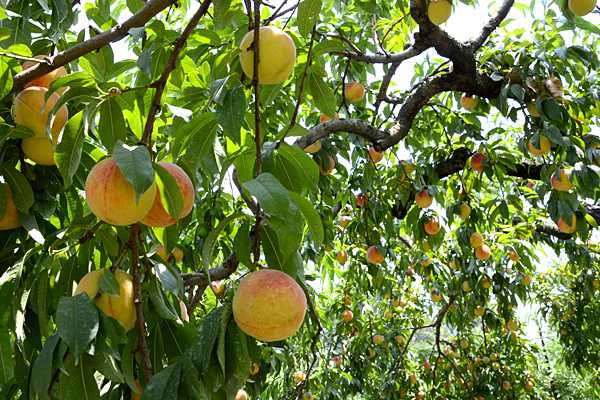
Peachy keen
Early August is usually height of harvest for Delaware's peach industry
12:02 p.m., Aug. 2, 2011--Things are looking peachy keen for Delaware’s small but important peach crop. The peak of the season is almost here – the first week of August is usually the height of the harvest.
“There were no freeze losses earlier this spring so it should be a full crop. I would say it’s going to be excellent,” says Gordon Johnson, a fruit and vegetable specialist for University of Delaware Cooperative Extension. Johnson is happy that conditions are good for Delaware’s four large commercial growers, as well as for a number of smaller growers in the area – like him.
Campus Stories
From graduates, faculty
Doctoral hooding
At his four-acre orchard, Johnson grows 44 different varieties of peaches, which he sells at a farm stand.
“Delaware’s peach industry is small but it’s not going away any time soon,” says Johnson. “In fact, the industry is growing. In the last decade, apple production has gone down but peach acreage has increased. Several farms have added orchards and there are now 300-plus acres in peach production in the state.”
The only possible cloud on the horizon is the brown marmorated stink bug, which has been an issue for peach growers in other states. Consultants started to see damage in commercial orchards in Kent and Sussex counties as early as the first part of June along edges near woods. However, stink bugs can quickly move into orchards so early detection is important, according to Joanne Whalen, an integrated pest management specialist with UD Cooperative Extension.
Peaches have grown in what is now Delaware for almost 500 years. The Spanish introduced peach trees to the region and by the 1600s, peaches were so abundant that farmers fed them to their pigs. By 1875, the state was the nation’s top peach producer and in 1895 the peach blossom was adopted as the state flower.
But disaster struck in the early 1900s when a powerful blight wiped out many orchards. The state’s peach industry climbed out of the pits after World War II but has never recovered its top ranking.
Today, Delaware produces about 2 million pounds of peaches each year. That’s miniscule compared to the number one state, California, which produces 950,000 tons annually, but it’s enough to guarantee an ample supply of local peaches from late June through early September.
Hail Bennett of Bennett Orchards in Frankford isn’t looking to compete with California growers or even other growers in the Mid-Atlantic. “We have established a bit of a niche market down here near the beach for locally grown, high quality tree-ripened peaches and are reluctant to put in larger acreages that would require us to ship peaches commercially and compete with so many other large growers in the region,” says Bennett.
Bennett Orchards has 50 acres of trees in production this month but by fall 25 acres will be taken out. Those trees are 15 years old and past their prime. The younger half of the orchard was planted four years ago as replacements but is only now coming into a high level of production.
Bennett’s 20 varieties of peaches run the gamut, from clingstones good for canning to freestone varieties for eating out of hand, including his favorite, Loring, a large variety that ripens in mid-season.
“It’s old fashioned and doesn’t always color as well as some of our newer varieties but the size and taste are hard to beat,” he says.
The Loring has yellow flesh, like 85 percent of all peaches grown in the U.S. But white-fleshed varieties have seen a surge in sales due to their lower acid content. Bennett grows one white-fleshed peach, a variety that ripens in late July.
At T.S. Smith and Sons in Bridgeville, Charlie Smith says that 25 percent of all peaches sold are white-fleshed varieties. Apples are what put T.S. Smith and Sons on the map; it’s the oldest commercial apple orchard in the state and the only one in Sussex County. In addition, the farm grows dozens of other fruits and vegetables, from sweet corn to watermelon. But peaches are an integral part of the business.
“Peaches are economically important to our farm,” says Smith. “We have been growing peaches for nearly all of our 104 years in operation. While there have been considerable improvements to the varieties that are suited to our area, growing peaches hasn’t changed much over the years.”
Regardless of whether you prefer yellow-fleshed or white-fleshed, all peaches are a good source of vitamin A and C, according to Kathleen Splane, a UD Cooperative Extension family and consumer science agent. They also have significant amounts of B vitamins, minerals and fiber. And if you don’t use them to create the official state dessert – peach pie – they’re low in calories, with only about 40 calories in a medium-sized fruit.
Here’s a fast, healthy peach recipe from Splane:
Fresh Peach Smoothie
1 cup sliced peaches (freeze for an extra thick smoothie)
1 cup plain yogurt
1 cup skim milk
1 tablespoon honey
Combine all ingredients in container of electric blender. Process until smooth.
Article by Margo McDonough
Photo by Danielle Quigley








